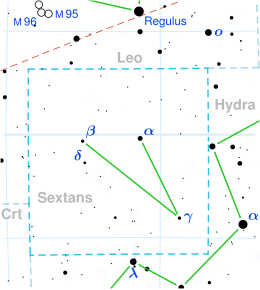| Observation data Epoch J2000.0 Equinox J2000.0 (ICRS) | |
|---|---|
| Constellation | Sextans |
| Right ascension | 10h 10m 55.86074s [1] |
| Declination | −08° 25′ 06.4527″ [1] |
| Apparent magnitude (V) | 5.62±0.01 [2] |
| Characteristics | |
| Spectral type | K2/3 III [3] |
| U−B color index | +1.42 [4] |
| B−V color index | +1.30 [4] |
| Astrometry | |
| Radial velocity (Rv) | 0.2±2.9 [5] km/s |
| Proper motion (μ) | RA: −0.115 mas/yr [1] Dec.: −43.987 mas/yr [1] |
| Parallax (π) | 5.8416±0.0881 mas [1] |
| Distance | 558 ± 8 ly (171 ± 3 pc) |
| Absolute magnitude (MV) | −0.16 [6] |
| Details | |
| Radius | 27.3±1.4 [7] R☉ |
| Luminosity | 222±12 [8] L☉ |
| Surface gravity (log g) | 1.72 [9] cgs |
| Temperature | 4,410±122 [10] K |
| Metallicity [Fe/H] | −0.31+0.01 −0.00 [11] dex |
| Rotational velocity (v sin i) | <1.0 [12] km/s |
| Other designations | |
| 18 Sex, 32 G. Sextantis [13] , BD−07°2977, GC 13990, HD 88333, HIP 49865, HR 3996, SAO 137395, TIC 26206896 [14] | |
| Database references | |
| SIMBAD | data |
18 Sextantis (HD 88333; HR 3996; 32 G. Sextantis), or simply 18 Sex, is a solitary star [15] located in the southern constellation Sextans. It is faintly visible to the naked eye as an orange-hued point of light with an apparent magnitude of 5.62. [2] Gaia DR3 parallax measurements imply a distance of 558 light-years [1] and it is slowly receding with a poorly constrained heliocentric radial velocity of approximately 0.2 km/s . [5] At its current distance, 18 Sex's brightness is diminished with an interstellar extinction of two-tenths of a magnitude [16] and it has an absolute magnitude of −0.16. [6]
18 Sex has a stellar classification of K2/3 III, [3] indicating that it is an evolved star with the characteristics of a K2 and K3 giant star. At present, it has exhausted hydrogen at its core and it has expanded to 27.3 times the radius of the Sun. [7] It radiates 222 times the luminosity of the Sun [8] from its enlarged photosphere at an effective temperature of 4,410 K . [10] Gaia DR3 models it to be a larger and brighter red giant branch star with a radius of 35.27 R☉ and a luminosity of 384 L☉. [1] 18 Sex is metal deficient with an iron abundance of [Fe/H] = −0.31 or 49% of the Sun's [11] and it spins too slowly for its projected rotational velocity to be measured accurately, having a velocity lower than 1.0 km/s . [12]
